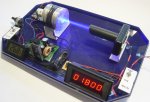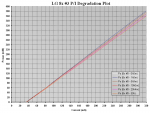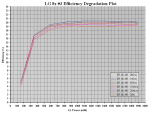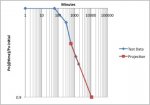30h Degradation Plots
Diode stats:
Ith =
36mA
Po @300mA =
334.5mW (= 93.96% of initial power - 364mW)
Slope Efficiency =
1.264mW/mA
Actual efficiency = 19.14% Peak / 18.88% Avg.
I calculated the average efficiency from the data points where the efficiency flattens out - starting at just under 600mW El. Power (120mA and up)..
What i find interesting is, that the degradation seems to be slowing down!
The first five hours left a noticable mark on the diode...
The second five hours caused the most degradation.
But then it took TEN additional hours to cause LESS degradation than the second five hours did!
And now the last ten hours of ON-time caused as little additional degradation as the first five. :thinking:
I mean, fact is, that the more the diode degrades, the lower it's output power - the lower the optical flux at the die, which is what causes it to degrade.. But at the same time, the imperfections (or in this case damage) should be growing and accumulating.
So while the optical flux is a little lower, it has more imperfections to put "pressure" on..
I was expecting the changes to become more and more noticable with time... I thought this was confirmed, when i saw the second 5h causing more degradation than the first... But then, five more hours didn't even cause a measurable difference, now it takes 10h to cause noticable degradation....
I also did some tests to see if any kinks might be developing, by allowing the diode to warm up at different currents (i removed it from the big heatsink, leaving it in the small one only), but it behaved normally - it would heat up, the Vf would drop and so would the power.
As soon as i reattached it to the big heatsink, the power returned to normal. I tried this at the current it is being cycled at first, then at higher (320mA) and lower currents (280 & 250), but nothing happened, it behaved as any normal healthy diode would..
The only thing changing is it's efficiency, which started out at 20.43% peak, 20.15% average, and dropped to 19.14% peak, 18.88% average..
Or in slope efficiency, 1.339mW/mA dropped to 1.264mW/mA..
I'm starting to wonder what the second diode will be like, and if there is a chance it would actually degrade faster due to a higher optical flux.
My assumption was, that the lower efficiency diode would degrade faster, and at the same power, i'm sure it would. But... No, i'm not gonna make any guesses right now, we should just wait and see.
The first diode surprised me in a positive way so far. If the second does the same, i'll be very happy!
From now on, i'll just measure the warm power during cycling after 10 more hours of ON-time, to see if there is a rapid drop indicative of a kink.
If not, since Ith is clearly not changing (the differences i noted initially were errors, since they go back and forth), all i need to make a degradation plot is the diode's power at 300mA with the diode cooled down...
I'll only re-plot it if i notice strange behavior - power rapidly dropping with heat and the spot splitting in two.










